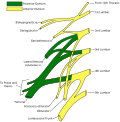Nerve block: Difference between revisions
From WikiMD's Wellness Encyclopedia
CSV import |
CSV import |
||
| Line 24: | Line 24: | ||
{{stub}} | {{stub}} | ||
<gallery> | |||
File:CT_image_guided_injection_pudendal_nerve.png|CT image guided injection of pudendal nerve | |||
File:Local_anesthetics_general_structure.svg|General structure of local anesthetics | |||
File:Gray808.png|Gray's Anatomy illustration of nerve block | |||
File:Lumbar_plexus.svg|Diagram of the lumbar plexus | |||
</gallery> | |||
Latest revision as of 04:46, 18 February 2025
Nerve block or neural blockade is a procedure in medicine and anesthesia whereby a nerve is blocked by the application of a drug or anesthetic. This prevents the nerve from transmitting signals and thus induces a loss of sensation or numbness.
Types of Nerve Blocks[edit]
There are several types of nerve blocks, including:
- Peripheral nerve blocks: These are often used in orthopedic procedures on the extremities. They can be used for both pain management and anesthesia.
- Neuraxial blocks: These include epidural and spinal anesthesia, which are commonly used in childbirth and surgeries involving the lower body.
- Sympathetic nerve block: This type of block is used to manage chronic pain conditions, such as complex regional pain syndrome.
Procedure[edit]
The procedure for a nerve block involves the injection of a local anesthetic near the nerve that is causing pain. The anesthetic works by numbing the area and blocking the nerve signals. This can provide temporary relief from pain.
Risks and Complications[edit]
Like any medical procedure, nerve blocks carry some risks. These can include infection, bleeding, and nerve damage. In rare cases, a nerve block can cause complications such as allergic reactions or respiratory distress.






